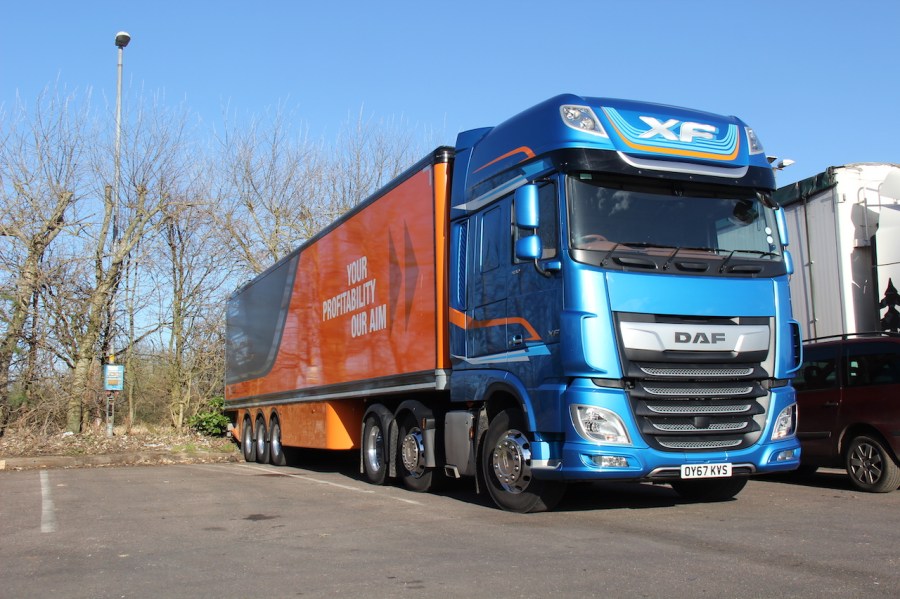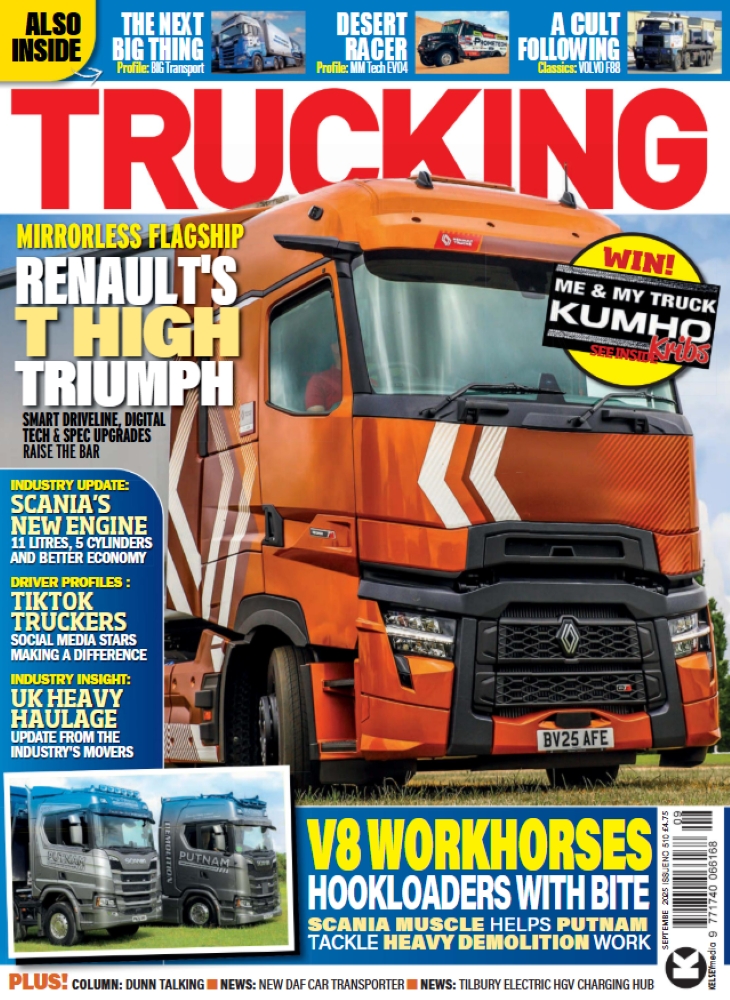The DAF XF530 is both a superb flagship yet a viable money-making tool that should please drivers, accountants and managers alike.
It’s assumed there’s a policy of American truck-builder PACCAR that if it ain’t broke, don’t fix it. Or, another could be: there’s no point in change for change’s sake. You only have to look at the longevity of some of its Kenworth and Peterbilt trucks to see that. And those mantras, it seems, also apply to PACAR’s European company, DAF.
While some people go on about the XF cab ‘being over 30 years old’, that statement is in fact not only irrelevant, I would also venture that now, it’s almost erroneous. You compare a 95.350 from 1987 with an XF480 and well, yes there are certainly similarities, but they are very, very different beasts indeed.
The new range of XF trucks was launched last year and you only have to look at the sheer numbers of the new models on the road to realise they have been an instant hit. The new CF and XFs might look as if they have only had (yet another) facelift, but the tweaks to the external appearance of the XF and CF, which are pretty minimal, hide the fact there were major changes to the drivelines. Under the cab, a lot has changed, and most of it for the better.
And despite its age, the XF’s current cab, especially in its Super Space Cab form, remains one of the best on the market. And there are many reasons for that.
The truck
The truck under scrutiny in this issue is the top-of-the-range XF530 FTG in 6×2 twin steer form; and with the Super Space Cab (SSC), it is mostly aimed at owner-drivers, small and prestige fleets. The cab is huge inside and ideal for those who either simply want a lot of room, or need it because of the length of the time they are on the road and away from home.
The SSC routinely wins awards and accolades from drivers for being the best in the business, and it’s easy to see why. It’s got lots of storage space and is well laid out. Of course, cabs are open to subjectivity and personal choice, but few trump the SSC.
Like most of the DAF range, the options sheet is impressive. For typical UK general haulage, you can have the XF530 as the 4×2 FT, the 6×2 FTP with the small mid-lift axle – which allows bigger fuel tanks or a reduced overall weight – and the FTR with a trailing lifting tag axle, favoured by those hauliers who have an element of off-road running, be it in quarries or landfill sites, or in forests on timber work. The tag-axle versions also seem to command a higher value when it comes to selling the vehicle on, mainly because they are rarer than the twin steers; supply and demand and all that.
The truck had the MX13 12.9-litre engine developing 530 bhp and 2600 Nm of torque. This is the most powerful version of the straight six, but you can have it at 480 or 430 bhp options as well. Other operators may prefer the 10.8-litre MX11 with an 180 kg weight saving. Cab-wise, as an alternative to the Super Space Cab – a high-roof sleeper – is also available, but the flat-roof sleeper or day cab options are not available on the XF in the UK, not that many operators would really need them.
The gearbox is the impressive 12-speed TraXon automated version – the 16-speed TraXon and 16-speed manual gearboxes are available as an option for the big DAFs – but most operators are likely to opt for the 12-speed ’box, and to be fair, it’s perfect for the job.
The driveline features the eight-tonne front axle, and the rear bogie is rated at 11.5 tonnes and includes the SR1344 drive axle. The tyres are 315/70R22.5.
On the road
We have always liked driving DAFs, so we were really looking forward to giving the big XF a decent run out, loaded fully at 44 tonnes. I was aware, even with 530 bhp, the XF was going to have to work hard on the few hills on our run from the DAF main headquarters at Thame in Oxfordshire to Chippenham.
The outward run saw us take the truck mostly over motorways pretty much all the way. While there was a little bit of A-road to cover on our immediate departure from Thame in order to join the southbound M40 at junction 8a, thereafter it was pretty much all motorway.
We headed south towards London and this involved quite a steep hill which made the big DAF work very hard. While we were overtaken by several other trucks, including many with less power, don’t read too much into that because not only were we at top weight, but we were also driving defensively to keep fuel usage to a minimum.
Indeed, driving this DAF really is a case of the truck doing what you want it to do; foot flat to the floor will allow you to romp up the hills, but comes at a price on the fuel consumption figure. So there is a best way to drive to be the most productive and earn you the most money, It’s better to use the cruise control and let the truck make its way up the hill in the most fuel-efficient way, and not necessarily at the quickest speed possible.
This highlights how important it is to train drivers on newer trucks. Old hands who’ve had their licences since the days of Atkinson Borderers might think they know everything about trucking, but if they are not paying the fuel bills, then they need to be given a proper hand-over. There’s a host of gadgetry on the XF to get the best out of it, and drivers need to be educated on that; but that education comes from DAF when you take delivery of the vehicle.
The return trip featured more A-road single-carriageways which called for more skill and control, but again the truck handled superbly, was responsive and a sheer joy to drive.
Better fuel
DAF claims the new XF range will be up to seven per cent better on fuel, and early indications from operators I’ve spoken to of both CFs and XFs seem to not only back that up, but even suggest their new trucks are achieving even greater fuel savings. Every extra mile to the gallon a truck delivers is worth about £3000 a year per truck on a typically worked, single-shifted truck.
The adaptive cruise control on the XF is a great piece of kit providing you know how to use it – and when you are using it, you keep your eye on it! It slows the truck down if it’s getting too close to a vehicle in front to minimise the chance of hitting it, but to keep your momentum the driver needs to be aware and ready to change lanes when the threat of being slowed down unnecessarily by a vehicle in front.
Some drivers I have spoken to find the ACC a little baffling/annoying/unnecessary to start with, but I think most who give it a chance, get to use it, and use it properly, will soon be thankful for its inclusion.
The steering on the XF is great and the cab interior is simply superb. The test truck we drove was admittedly the ‘top of the range’ with all the option boxes ticked, which meant the leather seats. Some (like us) might prefer cloth seats, but that is purely a matter of choice – but you have the choice. The ‘posh’ seats are certainly easier to clean and they are still very comfortable.
There is not a lot to fault the DAF on. The ‘moveable’ steering wheel does not have the same angles as, say, a Scania, and when you move the steering wheel out of the way to exit the truck when parked for a long time, it doesn’t actually move that much. It begs the question: is it worth it?
The doors also do not open a full 90 degrees, which can be a little annoying when getting in the cab – especially if carrying a bag, a coffee or the like. There are three big steps to get into the truck and access is generally pretty good.
We didn’t get to sleep in the truck, but the bunk is certainly spongy and comfortable. There is plenty of room in the cavernous Super Space Cab and it’s easy to see why it is so popular with drivers. There is room enough to stand up, even for the tallest driver, and it’s a fantastic cab for a week or more away from base.
Verdict
Should you plump for an XF530? Well, first up, let’s ignore the arguments that the 450 or 480 are better bets. Let’s look purely at the XF530 and its merits. It’s a great truck, and having seen many a stunning XF on the road, it certainly is a superb flagship.
DAFs are traditionally competitively priced and it is widely regarded you get a lot of truck for your money. Its competitors are the Scania S520, Volvo FH13.540, Iveco Stralis 510XP, Mercedes-Benz Actros 2551, Renault Range T High 520 and MAN TGX26.540. The XF530 is certainly better than some of those. It might be those old chestnuts of dealer back up, the deal you actually strike and a little bit of personal preference that dictate if it tops that list.
But one thing is certain: you won’t get short-changed or ripped off if you plump for an XF530, and it will certainly bridge that gap between a prestige truck and a viable money-making tool.
More information: http://www.daf.co.uk






